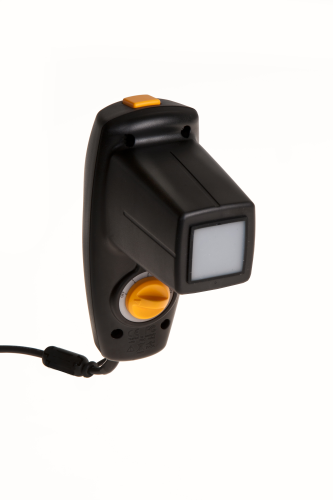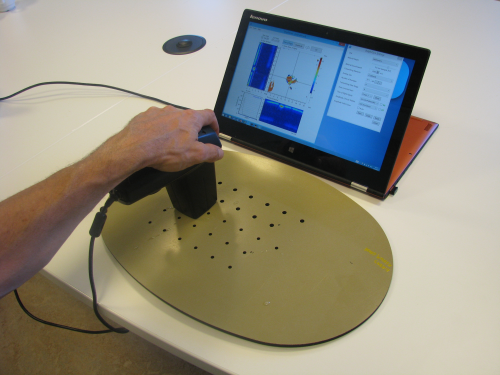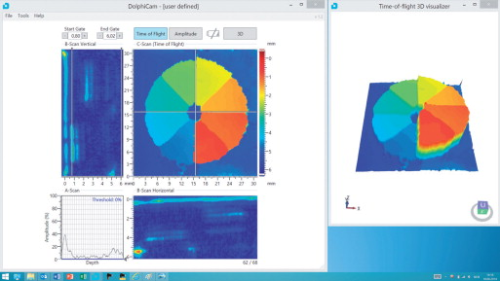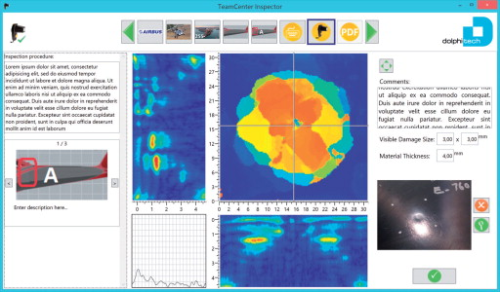




As the use of composite materials increase, manufacturers and maintenance organisations face the challenge of verifying the integrity of complex structures in novel materials. Manufacturers are concerned with the effects of tool wear- or break resulting in flawed drilled holes or delaminations. Then after a product is released to the market, traditional visual inspection - looking for dents - simply is not good enough when it comes to composite materials. Tap-testing has been used for a long time, but the method is limited to near-surface defects, is imprecise and has a number of potential pitfalls. Traditional NDT relying on experts with thousands of hours of training and experience and expensive NDT tools, is a model that is ready for an upgrade. DolphiCam is a handheld, mobile ultrasound camera system that is capable of detecting defects in carbon fibre materials. In May 2014, the DolphiCam was accepted for NDT on the Boeing 787 Dreamliner. DolphiTech is also working with Airbus on the certification of the technology for the new A350 XWB, an airplane model that starts delivery in 2014. Dropping a tool on a carbon fibre laminate might produce hidden defects hard to see with the human eye, even in optimal light conditions. Low-velocity/high energy impacts might weaken the structure to the point of breaking without any visible damages warning the user [1]. When DolphiTech was established in 2009, the goal was to make an ultrasound testing device that was much easier to use than all traditional equipment. The company had developed dense-element transducer technology that made it possible to create high-resolution images for reading bar codes engraved in metals. However, the same technology proved effective in finding defects in carbon fibre materials as well, and the company found an important supporter in European aircraft manufacturer Airbus that saw a need for better inspection tools. The DolphiCam Expert CF08 is the company’s first product, and it is optimised for up to 8mm thick carbon fibre reinforced plastic (CFRP). DolphiTech is working on a camera version that will penetrate materials double that thickness, to be released to the market in the autumn of 2014.
Standard Windows PC
DolphiCam connects through the USB port to a standard Windows PC that runs the DolphiCam user interface. The software displays A, B and C-scans (the C-scans in Time of Flight/TOF or Amplitude mode), and gets new data from the camera up to four times per second. Based upon the TOF data, a 3D image of a defect can be zoomed, tilted and panned, giving the inspector a more intuitive understanding of the damage and how a repair strategy should be developed. The 31×31 mm transducer face contains almost 16,000 transducer elements (124×124 elements), giving very detailed images. Camera settings and gating values can be changed to produce the best images on a given material and part geometry. An additional feature of the system is the silicone-based transducer face, enabling dry coupling (without water or contact gel) to materials that are painted or shiny. The DolphiCam itself has only two buttons; one for on/off/calibrate, and one for start and stop scanning. The calibration sequence takes a few seconds and is done towards air. After stopping the scan, the image in the user interface is frozen and can be measured or stored to disk. For larger areas of damage, a stitching mode supports (limited only by PC memory) multiple tile scans in any direction. Two stitching modes are possible. This is either by following the edges of defects in the material, or by following a 1×1 inch grid marked with ink on the surface of the material. DolphiTech decided that the poor scalability of traditional NDT technologies when it comes to personnel, competence and equipment cost meant that the development should go one-step further. How could it be possible to create an even simpler tool to help non-experts perform high quality NDT? In manufacturing, defects need to be addressed immediately. The manufacturing processes needs to be stopped and corrected before flawed materials and components flow downstream, creating even bigger quality problems. In service and maintenance, the challenge is to perform quick and precise assessments of structures with suspected damage. For this to be a reality, the NDT expert knowledge had to be embedded and encapsulated within the framework of an inspection procedure. This led to the development of DolphiTech TeamCenter software.
Library of inspection procedures
By using DolphiTech TeamCenter, a NDT expert creates a library of inspection procedures, and distributes this library to the team of field inspectors. An inspection procedure contains all the necessary information to perform an inspection, including textual instructions, sample in-situ pictures, example DolphiCam scans (examples on both good and bad situations), as well as a visual navigation path to the procedure. In addition, the expert attaches DolphiCam camera settings for the relevant CFRP material and geometry. Inspection libraries must be distributed efficiently across the enterprise to make sure that every field inspector has access to the latest and most current inspection instructions. However, not every PC is connected to the network all of the time. Therefore the concept must work in offline scenarios as well. DolphiTech TeamCenter libraries are stored as a single file that can be distributed over mail, or through a web or an intranet portal, available to the user and stored locally on a PC when it is connected. The DolphiTech TeamCenter application is developed for hand-held Windows tablets with a touch-screen interface. Large buttons and extended use of symbols make it easy to use in a rough environment, as would be expected in aircraft maintenance or in automotive body shops. One key feature in the development has been to make it easy to find the correct inspection procedure, even in a multilingual environment. A five-level navigation tree is made available to tailor the software to most needs, where a typical tree structure could be Brand > Model > Year model > Part > Critical part area or similar. After opening the appropriate library file, the field inspector navigates to the correct inspection procedure by clicking on large and visual buttons in the touch-screen user interface. After entering key data on the object to be inspected (worker id, object id, owner, reason for NDT etc.), the DolphiCam is automatically programmed with the correct settings for the part geometry and material. The field inspector reads the inspection procedure and loops through sample images before holding the camera to the material and performing the actual inspection. By using the traffic-light colour palette, the non-expert user can be visually warned if the transducer is not in contact with the material (white colour C-scan), if the part is good (blue colour means full back wall reflection), or if the part is flawed (indicated by a red colour C-scan).
Pictures
The inspection can be further enhanced with actual pictures from the damaged object, text descriptions of the damage or by adding more inspections to the report. When the field inspector has finished, a PDF report is automatically created, to be shared with an expert, an insurance company or other interested parties. Keeping aircraft in the air and cars with composite material structures on the road is critical. Traditional NDT equipment has not succeeded in encapsulating and hiding its underlying complexity for its users, and therefore needs highly educated personnel to be operated correctly and to interpret the results. DolphiTech TeamCenter opens up a concept that has been discussed in the business over a number of years, but has not been implemented in practical solutions - Remote NDT (RNDT). An NDT inspection on an object can now be performed when a non-expert is holding the camera and a remotely located expert can sign off the NDT inspection. Paired with tools for virtual presence (video conferencing) or even virtual enhanced reality (video overlay), experts can monitor and even influence inspections taking place on the other side of the world.
Conclusions
The use of new materials raises new challenges for material inspections. Visual inspection methods cannot be relied upon as the sole method to find defects in composite materials. Furthermore, traditional NDT scales badly, due to the need for highly trained personnel, and high equipment costs. A high-resolution ultrasound camera system such as DolphiCam paired with an easy-to-use application like TeamCenter can bring NDT out to the places where structural damages needs to be assessed immediately, saving both time and money.
References
1. ‘Reliability of Damage Detection in Advanced Composite Aircraft Structures’ (www.caa.co.uk/docs/33/Paper201303.pdf), from the Safety regulation Group of the UK CAA.
A Norwegian company founded in 2009, DolphiTech AS provides advanced ultrasound-based cameras for 2D and 3D identification, inspection and analysis of defects in composite materials. The company uses advanced technology developed by a team of experts in ultrasound, analogue and digital electronics.


